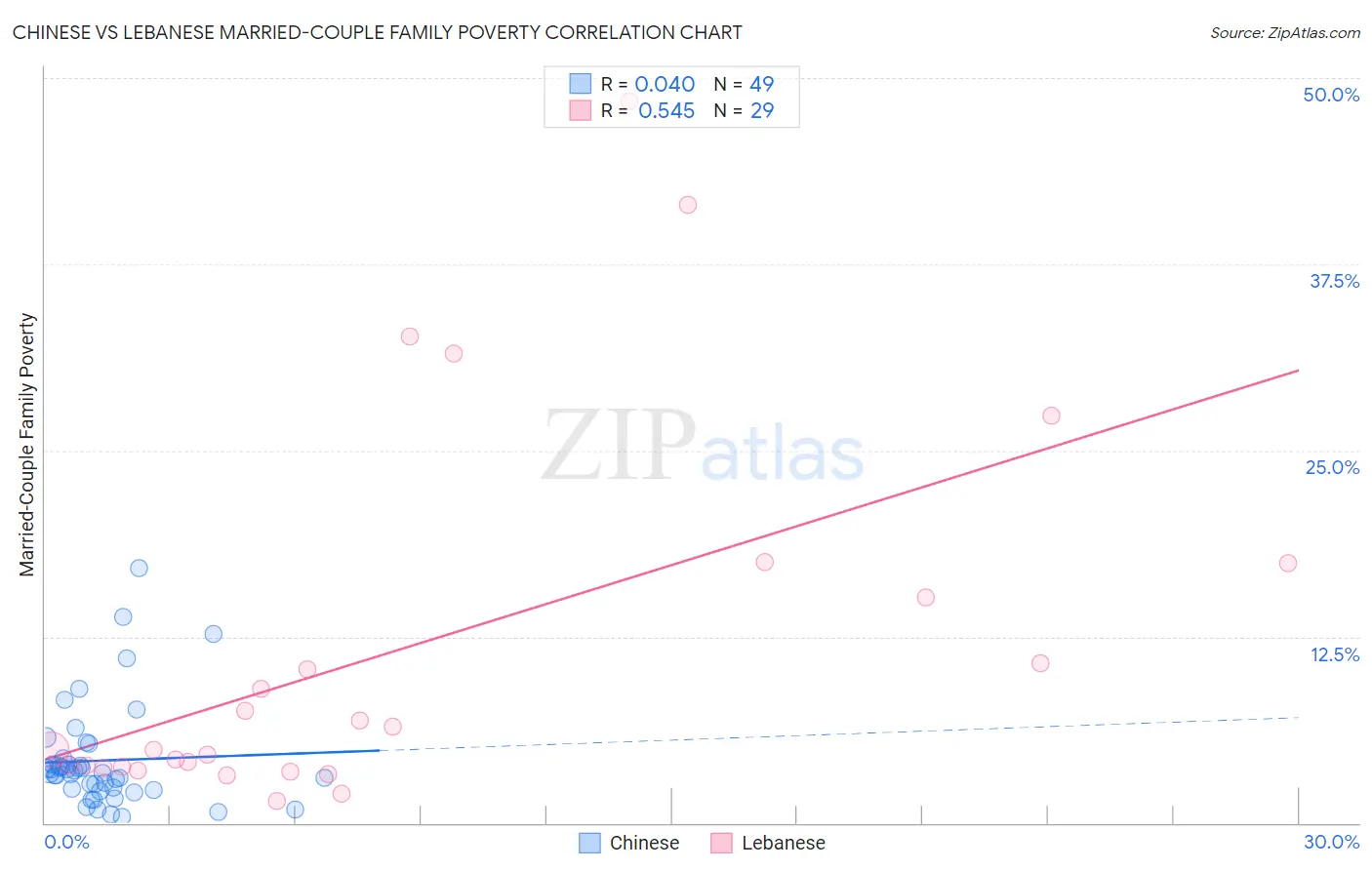Chinese vs Lebanese Married-Couple Family Poverty
COMPARE
Chinese
Lebanese
Married-Couple Family Poverty
Married-Couple Family Poverty Comparison
Chinese
Lebanese
3.6%
MARRIED-COUPLE FAMILY POVERTY
100.0/ 100
METRIC RATING
2nd/ 347
METRIC RANK
5.4%
MARRIED-COUPLE FAMILY POVERTY
24.1/ 100
METRIC RATING
201st/ 347
METRIC RANK
Chinese vs Lebanese Married-Couple Family Poverty Correlation Chart
The statistical analysis conducted on geographies consisting of 64,670,469 people shows no correlation between the proportion of Chinese and poverty level among married-couple families in the United States with a correlation coefficient (R) of 0.040 and weighted average of 3.6%. Similarly, the statistical analysis conducted on geographies consisting of 397,468,310 people shows a substantial positive correlation between the proportion of Lebanese and poverty level among married-couple families in the United States with a correlation coefficient (R) of 0.545 and weighted average of 5.4%, a difference of 47.9%.

Married-Couple Family Poverty Correlation Summary
| Measurement | Chinese | Lebanese |
| Minimum | 0.44% | 1.5% |
| Maximum | 17.1% | 48.5% |
| Range | 16.7% | 47.0% |
| Mean | 4.2% | 11.6% |
| Median | 3.3% | 4.9% |
| Interquartile 25% (IQ1) | 2.2% | 3.7% |
| Interquartile 75% (IQ3) | 4.1% | 16.3% |
| Interquartile Range (IQR) | 1.9% | 12.6% |
| Standard Deviation (Sample) | 3.4% | 12.6% |
| Standard Deviation (Population) | 3.4% | 12.4% |
Similar Demographics by Married-Couple Family Poverty
Demographics Similar to Chinese by Married-Couple Family Poverty
In terms of married-couple family poverty, the demographic groups most similar to Chinese are Immigrants from India (3.6%, a difference of 0.18%), Norwegian (3.7%, a difference of 1.9%), Slovene (3.8%, a difference of 5.6%), Swedish (3.9%, a difference of 5.7%), and Luxembourger (3.9%, a difference of 6.4%).
| Demographics | Rating | Rank | Married-Couple Family Poverty |
| Immigrants | India | 100.0 /100 | #1 | Exceptional 3.6% |
| Chinese | 100.0 /100 | #2 | Exceptional 3.6% |
| Norwegians | 100.0 /100 | #3 | Exceptional 3.7% |
| Slovenes | 100.0 /100 | #4 | Exceptional 3.8% |
| Swedes | 100.0 /100 | #5 | Exceptional 3.9% |
| Luxembourgers | 100.0 /100 | #6 | Exceptional 3.9% |
| Latvians | 100.0 /100 | #7 | Exceptional 3.9% |
| Thais | 100.0 /100 | #8 | Exceptional 3.9% |
| Croatians | 100.0 /100 | #9 | Exceptional 3.9% |
| Carpatho Rusyns | 100.0 /100 | #10 | Exceptional 3.9% |
| Lithuanians | 100.0 /100 | #11 | Exceptional 4.0% |
| Bulgarians | 100.0 /100 | #12 | Exceptional 4.0% |
| Czechs | 100.0 /100 | #13 | Exceptional 4.0% |
| Slovaks | 100.0 /100 | #14 | Exceptional 4.0% |
| Poles | 100.0 /100 | #15 | Exceptional 4.0% |
Demographics Similar to Lebanese by Married-Couple Family Poverty
In terms of married-couple family poverty, the demographic groups most similar to Lebanese are Immigrants from Morocco (5.4%, a difference of 0.020%), Immigrants from Middle Africa (5.4%, a difference of 0.060%), Uruguayan (5.4%, a difference of 0.13%), Immigrants from Belarus (5.4%, a difference of 0.30%), and Liberian (5.4%, a difference of 0.33%).
| Demographics | Rating | Rank | Married-Couple Family Poverty |
| Immigrants | Israel | 27.8 /100 | #194 | Fair 5.4% |
| Immigrants | Azores | 27.5 /100 | #195 | Fair 5.4% |
| Spaniards | 27.4 /100 | #196 | Fair 5.4% |
| Liberians | 26.3 /100 | #197 | Fair 5.4% |
| Immigrants | Belarus | 26.2 /100 | #198 | Fair 5.4% |
| Uruguayans | 25.0 /100 | #199 | Fair 5.4% |
| Immigrants | Morocco | 24.3 /100 | #200 | Fair 5.4% |
| Lebanese | 24.1 /100 | #201 | Fair 5.4% |
| Immigrants | Middle Africa | 23.8 /100 | #202 | Fair 5.4% |
| Immigrants | Peru | 21.8 /100 | #203 | Fair 5.4% |
| Immigrants | Costa Rica | 19.4 /100 | #204 | Poor 5.4% |
| Chippewa | 18.9 /100 | #205 | Poor 5.4% |
| Osage | 18.4 /100 | #206 | Poor 5.4% |
| Immigrants | Africa | 17.6 /100 | #207 | Poor 5.5% |
| French American Indians | 16.1 /100 | #208 | Poor 5.5% |